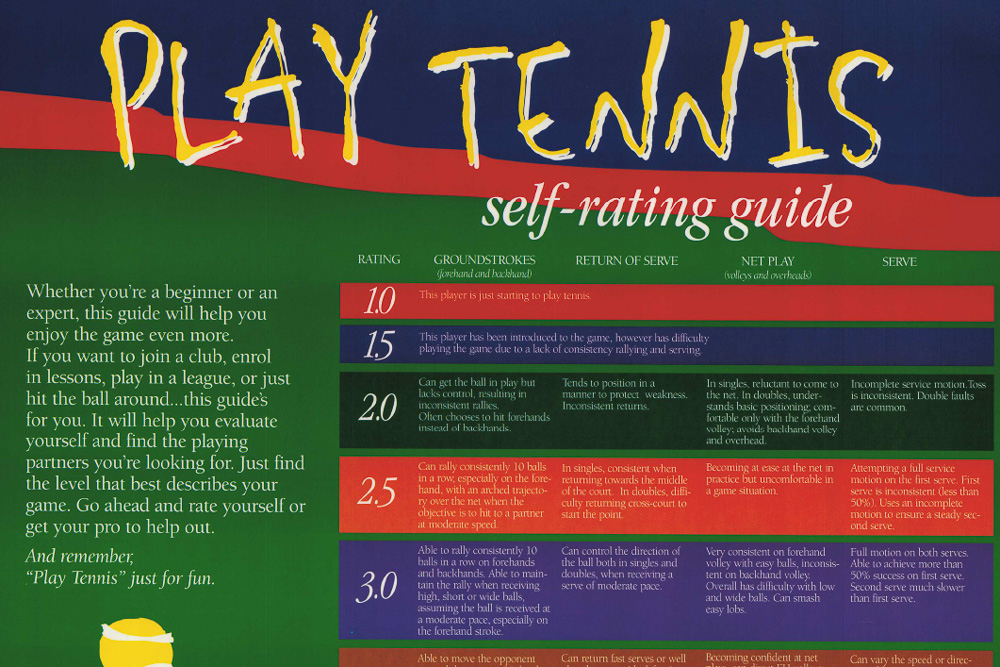Skill Levels in Tennis
Find Your Level — and Your Perfect Match
The Tennis School uses Tennis Canada’s “Play Tennis” self-rating system to help players identify their skill level, find the right program, and track their progress with confidence.
Why Skill Levels Matter
Research from the International Tennis Federation (ITF) shows that rating systems are one of the most effective tools for developing recreational players. They make it easier to find balanced matches, choose suitable programs, and measure improvement over time.
At The Tennis School, we use the Tennis Canada “Play Tennis” Self-Rating Guide, part of the ITF’s international development framework, to help players quickly and accurately understand their level.
The Play Tennis Self-Rating Guide
At the club’s lounge area, you’ll find a chart called the Self-Rating Guide. Take a moment to look it over and find the level that best describes your general play. You can also ask one of our coaches to help validate your self-evaluation.

The NTRP (National Tennis Rating Program) scale — used in Canada, the U.S., and by the ITF for recreational classification — officially goes from 1.0 to 7.0.
1.0 — New Player
Just starting to play tennis. Learning how to hold the racquet, rally, and keep score.
1.5 — Beginner
Has been introduced to the game but struggles with consistency in rallying and serving. Beginning to understand rules and positioning.
2.0 — Advanced Beginner
Can rally short exchanges but lacks control and consistency. In doubles, can position and return serves but still learning depth and placement.
2.5 — Developing Player
Can rally 10 balls with moderate pace and direction. Returns serve reliably and understands court positioning. Beginning to come to the net but still uncomfortable in live match play.
3.0 — Consistent Player
Can rally 10+ balls at moderate speed, control direction, and vary pace. Beginning to approach and volley confidently. Serve has some success; learning to place the ball more deliberately.
3.5 — Intermediate Player
Can sustain longer rallies, change pace and direction, and move opponents effectively. Can return serves with control and consistency. Starting to feel confident at the net with moderate pace and power.
4.0 — Competitive Player
Comfortable with all strokes and consistent in most match situations. Able to vary depth, spin, and strategy. Confident at the net and can place serves effectively.
4.5 — Advanced Player
Strong control, power, and strategy. Plays and competes regularly with an understanding of shot selection, pressure play, and tactical awareness.
5.0 — Tournament Player
Has developed dependable strokes with pace, depth, and placement. Competes in sanctioned tournaments or leagues. Comfortable handling pace, executing variety, and constructing points strategically.
5.5 — High-Performance Competitor
Has mastered a wide range of strokes and spins, adapts strategy effectively under pressure, and competes successfully at provincial or national levels. Regularly trains for conditioning, mental focus, and tactical refinement.
6.0 — National-Level Player
Plays at a national or collegiate level with advanced technique, strong physical conditioning, and consistent competitive experience. Demonstrates control, anticipation, and versatility under match pressure.
6.5 — International-Level Player
Competes successfully at international or semi-professional levels. Possesses elite consistency, tactical awareness, and mental focus. Regularly trains and competes year-round.
7.0 — Professional Player
World-class competitor on the ATP or WTA circuit. Plays at a professional international standard, with fully developed technical, tactical, physical, and psychological skill sets.
How to Know Your Rating
- Self-Assess: Read through the guide and choose the level that best matches your current consistency and comfort on court.
- Ask a Coach: Our certified coaches can quickly assess your game during a short on-court session.
- Play and Observe: The best confirmation comes from match play — how rallies feel, how often you control points, and how confident you are across all strokes.
Your rating isn’t about labels — it’s about helping you play at the right pace, with the right partners, and with goals that make sense for your development.
A good athlete always seeks to improve. Be open to trying something new. Learn to do it right. Practice, play, compete — and keep learning. That’s how every great player starts.
Ready?
Join a community that grows through the game. Discover what makes The Tennis School more than just a place to play.
Ask away